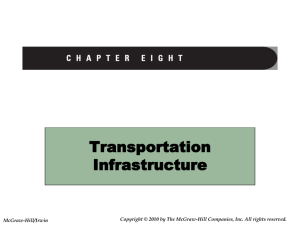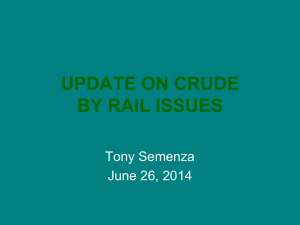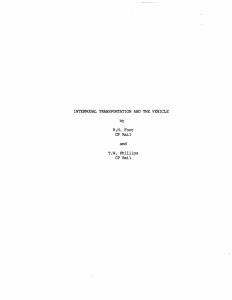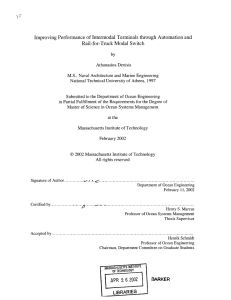Transportation in Supply Chain Management: Modes & Factors
advertisement
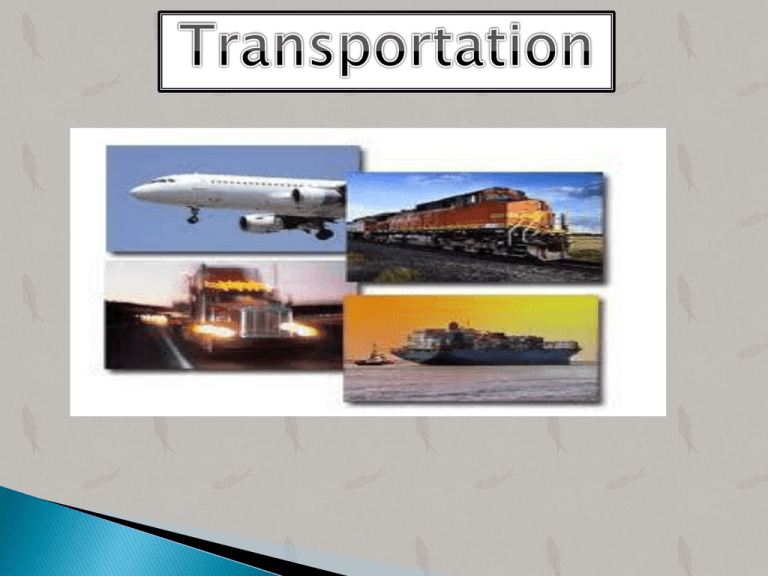
Transportation refers to the movement of product from one location to another as it makes its way from the beginning of supply chain to the customer. Transportation is an important supply chain driver because products are rarely produced and consumed in the same location. Shipper: the party who wants to transport the product from one place to another place. Carrier: Carrier is company that moves the goods from one place to another place. For example: DHL, Fed Ex. Etc. Modes of Transportation Air Inland Water Surface Package Carrier Oversea Road intermodal Rail Pipeline Trucking industry is divided into two parts i.e. TL: Truck Load and LTL: Less than Truck load. TL: TL pricing display the economic of scale with respect the distance travel. TL shipping suited for transportation between manufacturing facilities and warehouses. LTL: LTL operations are priced to encourage shipments in small lots, usually less than half a TL. LTL shipping is suites for shipments that are large to be mailed as small packages. Road Transport Advantages: It is a relatively cheaper mode of transport as compared to other modes. It is a flexible mode of transport as loading and unloading is possible at any destination. It provides door-to-door service. It helps to carry goods from one place to another, in places which are not connected by other means of transport like hilly areas. Limitations of Road transport: Due to limited carrying capacity road transport is not economical for long distance transportation of goods. Transportation of heavy goods or goods in bulk by road involves high cost. Air freighting is commonly used by companies who work with short lead times, or advanced service levels. Air transportation is best suited for small, high- value items or time sensitive emergency shipments that have to travel a long distance. Air carriers normally move shipments that have high value but light weight . Advantages of Air transportation: o It is the fastest mode of transport. o It is very useful in transporting goods to the area, which are not accessible by any other means. o Reduces lead time. o Improved service levels Disadvantages: o It is relatively more expensive mode of transport. o It is not suitable for transporting heavy and bulky goods. oIt is not suitable for short distance travel. Package carriers are transportation companies which carry small packages. Examples: FedEx, UPS, DHL. Etc. Package carrier use air, truck and rail to transport the goods. Packages carriers also provide other value added services that allow shippers to inventory flow and track order status, shipper can proactively inform the customer about their packages. Package carrier is suited for e- business. Rail transport uses freight trains for the delivery of merchandise. Freight trains are usually powered by diesel, electricity and steam. Rail is suited for bulk shipment of products like fertilizer, cement, food grains and coal etc. from the production plant to the warehouses. Advantages of Rail transportation: It is relatively faster than road transport. It is suitable for carrying heavy goods in large quantities over long distances. Cost effective. Limitations of Rail transportation: It is relatively expensive for carrying goods over short distances. It is not available in remote parts of the country. It provides service according to fixed time schedule and is not flexible for loading or unloading of goods at any place. Water transport uses ships and large commercial vessels that carry billions of tons of cargo. water transport is used primarily for the movement of large bulk commodity shipments and it is the cheapest mode for carrying such load. Water transport is particularly effective for significantly large quantities of goods that are non-perishable in nature and for cities or states that have water access. Advantages of water transportation: It is a relatively economical mode of transport for bulky and heavy goods. The cost of maintaining and constructing routes is very low most of them are naturally made. It promotes international trade. Disadvantages: The depth and navigability of rivers and canals vary and thus, affect operations of different transport vessels. It is a slow moving mode of transport and therefore not suitable for transport of perishable goods. It is adversely affected by weather conditions. Sea transport requires large investment on ships and their maintenance. Pipeline is used primarily for the transport of crude petroleum, refined petroleum products and natural gas. It include a significant initial fixed cost in setting up the pipeline and related infrastructure. Pipelines are not flexible and this scope is limited with respect to commodities. Unable to transport a variety of materials Intermodal Transportation is use of more than one mode of transport for the movement of shipment from origin to its destination. Intermodal operation is used two or more mode of transport to take the advantage of inherent economies of each and thus provide the integrated service at lower cost. For example: truck/water/rail. Therefore transportation plays very important role in the supply chain to distribute the goods from one place to the another place or we can say that to the customers. Economic factor Environment factors Factors influencing transportation Geographical factors Technological factors

